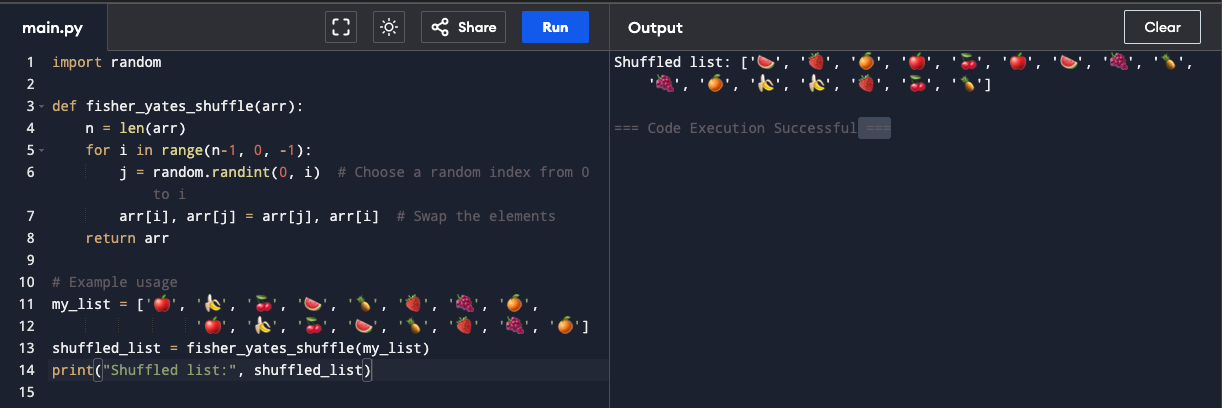Shuffling data is a common operation in many applications, ranging from card games and lottery draws to algorithms that require random permutations of elements. One of the most efficient ways to achieve this randomness is through the Fisher-Yates shuffle algorithm. In this blog, we will dive deep into what the Fisher-Yates shuffle is, how it works, and why it’s an optimal choice for randomizing elements in a list or array.
What is the Fisher-Yates Shuffle?
The Fisher-Yates shuffle (also called the Knuth shuffle) is a simple, efficient algorithm for randomly rearranging the elements of a finite sequence, such as an array or a list. It was first proposed by Ronald Fisher and Frank Yates in 1938, and later popularized by Donald Knuth in his book The Art of Computer Programming.
Unlike some other shuffling algorithms, the Fisher-Yates shuffle produces a truly random permutation of the input array with equal probability for every possible order. This means that every element has the same chance of appearing in any position in the array.
How Does the Fisher-Yates Shuffle Work?
The core idea behind the Fisher-Yates shuffle is to iterate through the array from the last element to the second element, and for each element, swap it with a randomly chosen element that comes before or at the current position.
Here is the step-by-step process:
- Start with an array of
nelements (let’s call itarr[0],arr[1], …,arr[n-1]). - Begin at the last element (
arr[n-1]), and generate a random indexjbetween0andi(the current index). - Swap the elements
arr[i]andarr[j]. - Move to the previous element (
i-1), repeat the process until you reach the first element.
By the time you reach the first element, the array will be randomly shuffled!
Pseudocode
Here’s a simplified pseudocode version of the algorithm:
for i = n-1 down to 1 do:
j = random(0, i)
swap(array[i], array[j])Where:
random(0, i)generates a random index between0andi.swap(array[i], array[j])swaps the values at indicesiandj.
Why Fisher-Yates Shuffle?
You might wonder, why should we use the Fisher-Yates shuffle over other random shuffling methods? There are several reasons:
- Uniform Distribution: The Fisher-Yates shuffle guarantees that all possible permutations of the array are equally likely. In contrast, some other algorithms, like the naive approach of repeatedly selecting random positions and swapping, might not produce a uniform distribution of permutations.
- Efficiency: The Fisher-Yates shuffle runs in O(n) time, where
nis the number of elements in the array. This is optimal for randomizing an array, as each element is processed once. - Simplicity: The algorithm is straightforward to implement and doesn’t require any additional memory or complex operations.
Example Implementation in Python
Here’s a Python implementation of the Fisher-Yates shuffle:
import random
def fisher_yates_shuffle(arr):
n = len(arr)
for i in range(n-1, 0, -1):
j = random.randint(0, i) # Choose a random index from 0 to i
arr[i], arr[j] = arr[j], arr[i] # Swap the elements
return arr
# Example usage
my_list = [1, 2, 3, 4, 5]
shuffled_list = fisher_yates_shuffle(my_list)
print("Shuffled list:", shuffled_list)In this example, we define a function fisher_yates_shuffle that accepts a list and shuffles it in place. The function uses the random library to pick indices and swap the elements.
Key Points to Remember
- The Fisher-Yates shuffle ensures that all possible permutations are equally likely, making it a fair and unbiased algorithm.
- It operates in linear time O(n), which is the best possible time complexity for shuffling an array.
- The algorithm is in-place, meaning it doesn’t require any additional space besides the input array, making it space-efficient.
Conclusion
The Fisher-Yates shuffle is an elegant, efficient, and unbiased algorithm for randomizing the elements of an array or list. Whether you’re working on a card game, a lottery system, or any other application requiring random orderings, the Fisher-Yates shuffle is a great tool to have in your programming toolkit.
If you’re working with random data, you now have a robust understanding of how to implement and use this algorithm in your own projects.


Leave a Reply